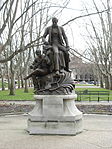Schenley Plaza

Schenley Plaza is a public park serving as the grand entrance into Schenley Park in Pittsburgh, Pennsylvania.The 4.5-acre (18,000 m2) plaza, located on Forbes Avenue and Schenley Drive in the city's Oakland district, includes multiple gardens, food kiosks, public meeting spaces, a carousel, and a prominent 1.0-acre (4,000 m2) "Emerald Lawn" with free wireless internet access. The plaza is the site of the Mary Schenley Memorial Fountain, the Christopher Lyman Magee Memorial, the University of Pittsburgh's Frick Fine Arts Building, and formerly the Stephen Foster sculpture. The plaza is also surrounded by many prominent landmarks, including the University of Pittsburgh's Cathedral of Learning, Stephen Foster Memorial, Hillman Library, and Posvar Hall as well as the Carnegie Institute and its Dippy sculpture.
Excerpt from the Wikipedia article Schenley Plaza (License: CC BY-SA 3.0, Authors, Images).Schenley Plaza
Schenley Drive, Pittsburgh
Geographical coordinates (GPS) Address Nearby Places Show on map
Geographical coordinates (GPS)
| Latitude | Longitude |
|---|---|
| N 40.442672 ° | E -79.952567 ° |
Address
Schenley Plaza Pavillion
Schenley Drive
15213 Pittsburgh
Pennsylvania, United States
Open on Google Maps









